Konica Minolta DiMAGE S414 User Manual
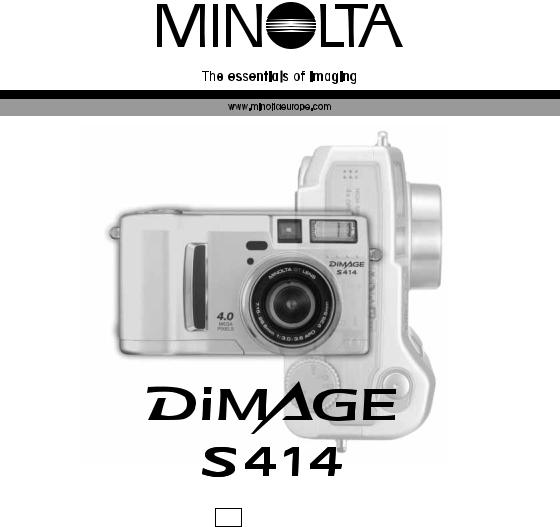
E INSTRUCTION MANUAL
9222-2799-11 PR-A212/ME0302

BEFORE YOU BEGIN
Thank you for purchasing this Minolta digital camera. Please take the time to read through this instruction manual so you can enjoy all the features of your new camera. Check the packing list before using this product. If any items are missing, immediately contact your camera dealer.
Minolta DiMAGE S414 digital camera
AA alkaline batteries (set of four)
Neck strap NS-DG304
Lens cap LF-236
CompactFlash card
AV cable AVC-100
USB cable USB-600
DiMAGE Viewer CD-ROM
DiMAGE Viewer instruction manual (PDF)
Camera manual (PDF)
Quick Reference Guide
Minolta International Warranty Certificate
Camera Notes
Because the performance of alkaline batteries with digital cameras is low, the use of Ni-MH batteries is recommended. Although alkaline batteries are supplied with this product, its performance will be limited; only use alkaline batteries for test photographs or when Ni-MH batteries, the Minolta external battery pack, or the AC adapter are not available. Fully recharge the Ni-MH batteries just before using the camera.
Apple, the Apple logo, Macintosh, Power Macintosh, Mac OS, and the Mac OS logo are registered trademarks of Apple Computer Inc. Microsoft and Windows are registered trademarks of the Microsoft Corporation. The official name of Windows is Microsoft Windows Operating System. Pentium is a registered trademark of the Intel Corporation. Power PC is a trademark of the International Business Machines Corporation. QuickTime is a trademark used under license. All other trademarks are the property of their respective owners.
 2
2 
 BEFORE YOU BEGIN
BEFORE YOU BEGIN









































FOR PROPER AND SAFE USE
Read and understand all warnings and cautions before using this product.
 WARNING
WARNING
Using batteries improperly can cause them to leak harmful solutions, overheat, or explode which may damage property or cause personal injury. Do not ignore the following warnings.
•Only use the batteries specified in this instruction manual.
•Do not install the batteries with the polarity (+/–) reversed.
•Do not use batteries which show wear or damage.
•Do not expose batteries to fire, high temperatures, water, or moisture.
•Do not attempt to short or disassemble batteries.
•Do not store batteries near or in metallic products.
•Do not mix batteries of different types, brands, ages, or charge levels.
•Do not charge alkaline batteries.
•When recharging rechargeable batteries, only use the recommended charger.
•Do not use leaking batteries. If fluid from the batteries enters your eye, immediately rinse the eye with plenty of fresh water and contact a doctor. If fluid from the batteries makes contact with your skin or clothing, wash the area thoroughly with water.
•Tape over battery contacts to avoid short-circuiting during disposal; always follow local regulations for battery disposal.
•Use only the specified AC adapter within the voltage range indicated on the adapter unit. An inappropriate adapter or current may cause damage or injury through fire or electric shock.
•Do not disassemble this product. Electric shock may cause injury if a high voltage circuit inside the product is touched.
•Immediately remove the batteries or unplug the AC adapter and discontinue use if the camera is dropped or subjected to an impact in which the interior, especially the flash unit, is exposed. The flash has a high voltage circuit which may cause an electric shock resulting in injury. The continued use of a damaged product or part may cause injuries or fire.
•Keep batteries or small parts that could be swallowed away from infants. Contact a doctor immediately if an object is swallowed.






















































 3
3

•Store this product out of reach of children. Be careful when around children not to harm them with the product or parts.
•Do not fire the flash directly into the eyes. It may damage eyesight.
•Do not fire the flash at vehicle operators. It may cause a distraction or temporary blindness which may lead to an accident.
•Do not use the monitor while operating a vehicle or walking. It may result in injury or an accident.
•Do not look directly at the sun or strong light sources through the viewfinder. It may damage your eyesight or cause blindness.
•Do not use this product in a humid environment, or operate this product with wet hands. If liquid enters the product, immediately remove the batteries or unplug the AC adapter and discontinue use. The continued use of a product exposed to liquids may cause damage or injury through fire or electric shock.
•Do not use the product near inflammable gases or liquids such as gasoline, benzine, or paint thinner. Do not use inflammable products such as alcohol, benzine, or paint thinner to clean the product. The use of inflammable cleaners and solvents may cause an explosion or fire.
•When unplugging the AC adapter, do not pull on the power cord. Hold the adapter unit when removing it from an outlet.
•Do not damage, twist, modify, heat, or place heavy objects on the AC adapter cord. A damaged cord may cause damage or injury through fire or electric shock.
•If the product emits a strange odor, heat, or smoke, discontinue use. Immediately remove the batteries taking care not to burn yourself as the batteries become hot with use. The continued use of a damaged product or part may cause injuries or fire.
•Take the product to a Minolta Service Facility when repairs are required
 CAUTION
CAUTION
•Do not use or store the product in a hot or humid environment such as the glove compartment or trunk of a car. It may damage the product and batteries which may result in burns or injuries caused by heat, fire, explosion, or leaking battery fluid.
•If batteries are leaking, discontinue use of the product.
 4
4 
 FOR PROPER AND SAFE USE
FOR PROPER AND SAFE USE



































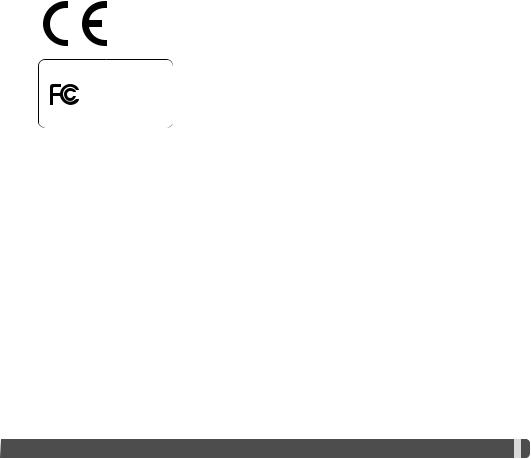
•The camera temperature rises with extended periods of use. Care should be taken to avoid burns.
•Burns may result if the memory card or batteries are removed immediately after extended periods of use.
Turn the camera off and wait for it to cool.
• Do not fire the flash while it is in contact with people or objects. The flash unit discharges a large amount of energy which may cause burns.
•Do not apply pressure to the LCD monitor. A damaged monitor may cause injury, and the liquid from the monitor may cause inflammation. If liquid from the monitor makes contact with skin, wash the area with fresh water. If liquid from the monitor comes in contact with the eyes, immediately rinse the eyes with plenty of water and contact a doctor.
•When using the AC adapter, insert the plug securely into the electrical outlet.
•Do not use if the AC adapter cord is damaged.
•Do not cover the AC adapter. A fire may result.
•Do not obstruct access to the AC adapter; this can hinder the unplugging of the unit in emergencies.
•Unplug the AC adapter when cleaning or when the product is not in use.
The following marks may be found on the product:
This mark on your camera certifies that this camera meets the requirements of the EU (European Union) concerning interference causing equipment regulations. CE stands for Conformité Européenne (European Conformity).
Digital Camera: 




Tested To Comply
With FCC Standards
FOR HOME OR OFFICE USE
This device complies with Part 15 of the FCC Rules. Operation is subject to the following two conditions: (1) This device may not cause harmful interference, and (2) this device must accept any interference received, including interference that may cause undesired operation. Do not remove the ferrite cores from the cables.
Tested by the Minolta Corporation
101 Williams Drive, Ramsey, New Jersey 07446, U.S.A.
This Class B digital apparatus complies with Canadian ICES-003.
Cet appareil numérique de la classe B est conforme à la norme NMB-003 du Canada.






















































 5
5

TABLE OF CONTENTS
The basic operation of this camera is covered between pages 15 and 42. This section of the manual covers the camera parts, preparation of the camera for use, and the basic camera operation for recording, viewing, and deleting images.
The basic and advanced auto-recording mode sections cover all the basic functions of the camera in this mode and in the multi-function recording mode. Take time to read these sections before moving on to the multi-function recording mode section. The basic playback section describes how to view images. The other sections can be read as needed.
Many of the features of this camera are controlled with menus. The menu navigation sections concisely describe how to change menu settings. Descriptions of the settings immediately follow the navigation sections.
Throughout the text are shooting tips and camera notes. Shooting tips give advice and information on photography and how to use the camera to achieve the best results. Camera notes cover details on camera operation.
Names of parts..................................................................................................................................... |
10 |
Camera body ........................................................................................................................... |
10 |
Viewfinder ................................................................................................................................ |
12 |
Mode dial ................................................................................................................................. |
12 |
Data panel ............................................................................................................................... |
13 |
LCD monitor display ................................................................................................................ |
14 |
Getting up and running......................................................................................................................... |
15 |
Attaching the neck strap and lens cap .................................................................................... |
15 |
Changing batteries .................................................................................................................. |
16 |
Battery condition indicator ....................................................................................................... |
17 |
Auto power save ...................................................................................................................... |
17 |
External power supplies (sold separately)............................................................................... |
18 |
Changing the CompactFlash card........................................................................................... |
18 |
Setting the date and time ........................................................................................................ |
20 |
Auto-recording mode - basic operation ................................................................................................ |
22 |
Setting the camera to record images automatically ................................................................ |
23 |
Handling the camera ............................................................................................................... |
24 |
Using the zoom lens................................................................................................................ |
24 |
 6
6 
 TABLE OF CONTENTS
TABLE OF CONTENTS 









































Basic recording operation........................................................................................................ |
25 |
Focus lock................................................................................................................................ |
26 |
Focus range............................................................................................................................. |
26 |
Focus signals........................................................................................................................... |
27 |
Special focusing situations ...................................................................................................... |
27 |
Digital-subject-program button................................................................................................. |
28 |
Flash modes ............................................................................................................................ |
30 |
Flash range - auto-recording mode ......................................................................................... |
31 |
Flash signals............................................................................................................................ |
31 |
Camera-shake warning ........................................................................................................... |
31 |
Drive modes ............................................................................................................................ |
32 |
Self-timer ................................................................................................................................. |
33 |
Remote control (sold separately) ............................................................................................ |
34 |
Continuous advance ................................................................................................................ |
35 |
Bracketing................................................................................................................................ |
36 |
Display button - recording mode ............................................................................................. |
37 |
Playback - basic operation ................................................................................................................... |
38 |
Single-frame playback and histogram display ......................................................................... |
38 |
Viewing and deleting images................................................................................................... |
39 |
Display button - playback......................................................................................................... |
40 |
Enlarged playback ................................................................................................................... |
41 |
Auto-recording mode - advanced operation......................................................................................... |
42 |
Navigating the auto-recording mode menu ............................................................................. |
42 |
Image size and image quality.................................................................................................. |
44 |
Voice memo ............................................................................................................................. |
46 |
Date imprinting ........................................................................................................................ |
47 |
Digital zoom............................................................................................................................. |
48 |
Instant playback....................................................................................................................... |
49 |
Exposure compensation .......................................................................................................... |
50 |
What is an Ev? What is a stop? .............................................................................................. |
51 |
Multi-function recording mode.............................................................................................................. |
52 |
Autofocus areas and control.................................................................................................... |
52 |
Navigating the multi-function recording mode menu ............................................................... |
54 |
Exposure modes...................................................................................................................... |
56 |
Program.............................................................................................................................. |
56 |
Aperture priority - A............................................................................................................ |
56 |
Manual exposure - M.......................................................................................................... |
57 |
Bulb exposures ........................................................................................................................ |
58 |
Focus modes ........................................................................................................................... |
59 |
White balance.......................................................................................................................... |
60 |
Automatic white balance..................................................................................................... |
60 |
Preset white balance .......................................................................................................... |
60 |
Custom white balance ........................................................................................................ |
61 |
Camera sensitivity - ISO.......................................................................................................... |
62 |
Flash range and camera sensitivity......................................................................................... |
62 |
Full-time AF ............................................................................................................................. |
63 |
Metering modes....................................................................................................................... |
63 |
Exposure bracketing increment ............................................................................................... |
64 |
Color mode .............................................................................................................................. |
64 |
Image control - sharpness, contrast, & filter............................................................................ |
65 |






















































 7
7

A short guide to photography............................................................................................................... |
66 |
Movie recording.................................................................................................................................... |
68 |
Notes on movie recording ....................................................................................................... |
69 |
Recording movies with the IR Remote Control RC-3 (sold separately) .................................. |
69 |
Playback mode - advanced operation .................................................................................................. |
70 |
Playing back voice memos ...................................................................................................... |
70 |
Viewing movies........................................................................................................................ |
71 |
Navigating the playback-mode menu ...................................................................................... |
72 |
Frame-selection screen ........................................................................................................... |
74 |
Viewing images on a television ............................................................................................... |
75 |
Deleting files ............................................................................................................................ |
76 |
Locking files............................................................................................................................. |
77 |
Changing the index playback format ....................................................................................... |
77 |
Slide Show............................................................................................................................... |
78 |
About DPOF ............................................................................................................................ |
80 |
Creating a DPOF print order ................................................................................................... |
80 |
Ordering an index print............................................................................................................ |
81 |
Canceling a DPOF print order ................................................................................................. |
81 |
Copying images ....................................................................................................................... |
82 |
Setup mode ....................................................................................................................................... |
84 |
Navigating the setup menu...................................................................................................... |
84 |
LCD monitor brightness........................................................................................................... |
86 |
Formatting CompactFlash cards ............................................................................................. |
86 |
Auto power save ...................................................................................................................... |
86 |
Language................................................................................................................................. |
87 |
Display mode ........................................................................................................................... |
87 |
File number (#) memory .......................................................................................................... |
88 |
Folder name............................................................................................................................. |
88 |
Select folder............................................................................................................................. |
89 |
Audio signals ........................................................................................................................... |
89 |
Shutter FX ............................................................................................................................... |
89 |
Volume..................................................................................................................................... |
89 |
Resetting the camera .............................................................................................................. |
90 |
Date and time setting .............................................................................................................. |
91 |
Date format.............................................................................................................................. |
91 |
Video output ............................................................................................................................ |
91 |
 8
8 
 TABLE OF CONTENTS
TABLE OF CONTENTS 









































Data-transfer mode............................................................................................................................... |
92 |
System requirements............................................................................................................... |
92 |
Connecting the camera to a computer .................................................................................... |
93 |
Connecting to Windows 98 and 98 Second Edition ................................................................ |
95 |
Automatic installation.......................................................................................................... |
95 |
Manual installation.............................................................................................................. |
96 |
CompactFlash card folder organization................................................................................... |
98 |
Disconnecting the camera from the computer ...................................................................... |
100 |
Windows 98 and 98 Second Edition ................................................................................ |
100 |
Windows Me, 2000 Professional, and XP ........................................................................ |
100 |
Macintosh ......................................................................................................................... |
101 |
Changing the CompactFlash card - data-transfer mode ....................................................... |
102 |
Auto power save - data-transfer mode .................................................................................. |
102 |
QuickTime system requirements ........................................................................................... |
103 |
Appendix ..................................................................................................................................... |
103 |
Troubleshooting ..................................................................................................................... |
103 |
About Ni-MH batteries ........................................................................................................... |
105 |
Removing the driver software - Windows .............................................................................. |
106 |
Care and storage................................................................................................................... |
107 |
Technical specifications ......................................................................................................... |
110 |






















































 9
9
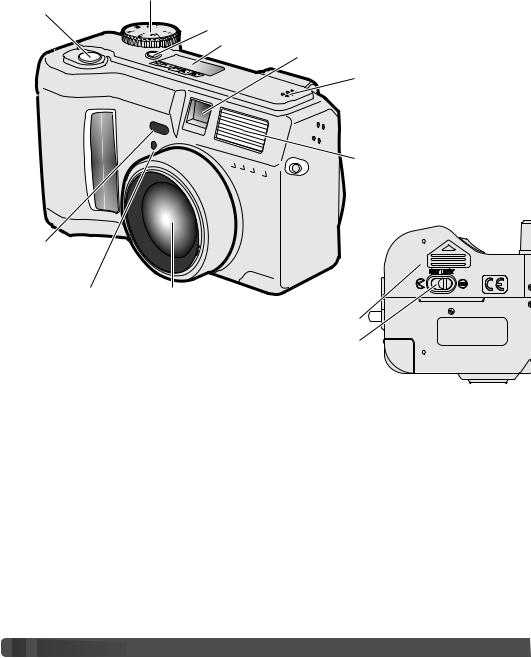
CAMERA BODY
* This camera is a sophisticated optical instrument. Care should be taken to keep these surfaces clean. Please read the care and storage instructions in the back of this manual (p. 107).
Mode dial (main switch)
Shutter-release button
Digital-subject-program button (p. 28)
Data panel (p. 13)
Viewfinder window*
Microphone

 Speaker
Speaker
Flash (p. 30)
 Strap eyelet (p. 15)
Strap eyelet (p. 15)
Remote-control
receiver
Self-timer/ |
Lens* |
Remote-control |
|
lamp (p. 33) |
|
Battery-chamber door (p. 16)
Battery-chamber lock (p. 16)
 10
10 
 NAMES OF PARTS
NAMES OF PARTS 










































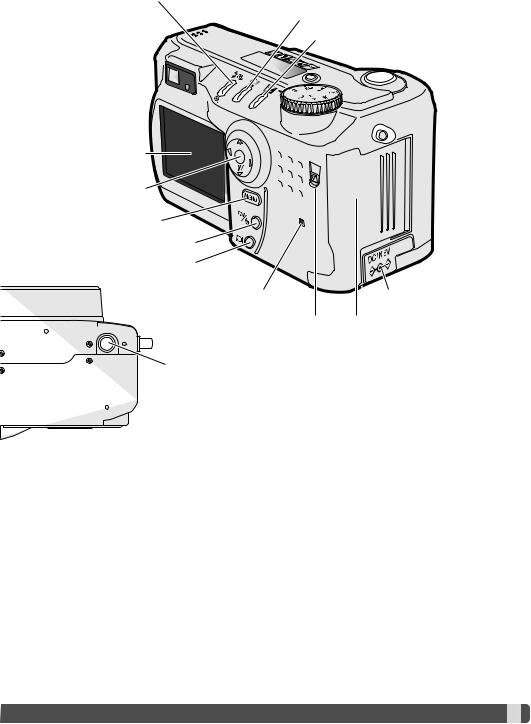
Flash mode/Magnification button (p. 30, 41)
Drive-mode button (p. 32)
Exposure-compensation button (p. 50)
Viewfinder* (p. 12) 

LCD monitor* |
|
(p. 14) |
|
Controller |
|
Menu button |
|
QV/ Delete button (p. 38) |
|
Display button (p. 37, 40) |
|
Access lamp |
DC terminal cover (p. 18) |
Card-slot door release |
Card-slot door (p. 18) |
|
The USB port and AV-out terminal |
|
are located behind the card-slot door. |
Tripod socket |
|





















































 11
11
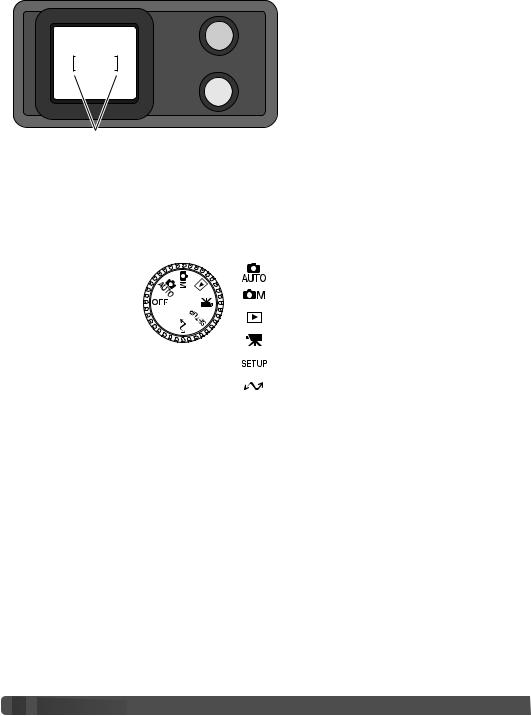
VIEWFINDER
 Focus lamp (green)
Focus lamp (green)
 Flash lamp (orange)
Flash lamp (orange)
Focus frame
Because the optical viewfinder and the lens are slightly separated, the image seen through one is not exactly the same as the other; this is called parallax. Parallax can cause errors in framing at close distances and is more pronounced at longer focal lengths. When the subject is closer than 1m (3ft) at the wide-angle lens position or 3m (10ft) at the telephoto lens position, use the LCD monitor to compose the image; because the lens creates the monitor image, it does not suffer from parallax.
MODE DIAL
This dial gives direct and easy access to the camera’s major modes. It also acts as the main switch.
Auto-recording mode (p. 22, 42)
Multi-function recording mode (p. 52)
Playback mode (p. 38, 70)
Movie-recording mode (p. 68)
Setup mode (p. 84)
Data-transfer mode (p. 92)
 12
12 
 NAMES OF PARTS
NAMES OF PARTS 










































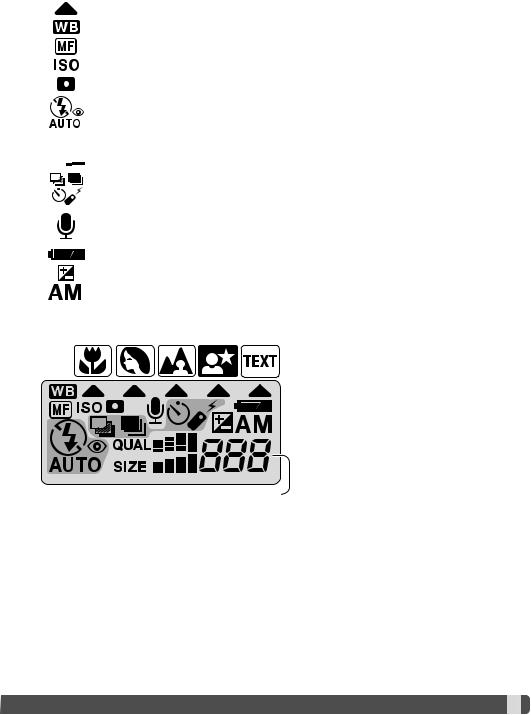
DATA PANEL
Digital-subject-program indicators (p. 28) White-balance indicator (p. 60) Manual-focus indicator (p. 59) Camera-sensitivity indicator (p. 62)
Spot-metering indicator (p. 63)
Flash-mode indicators (p. 30)





 Image-size display (p. 44)
Image-size display (p. 44) 







 Image-quality display (p. 44)
Image-quality display (p. 44)
Drive-mode indicators (p. 32)
Microphone indicator (p. 46)
Battery-condition indicator (p. 17)
Exposure-compensation indicator (p. 50)
Exposure-mode indicators (p. 56)
Digital-subject-program icons (p. 28)
Frame counter (p. 45)
The frame counter cannot exceed 999. When the number of recordable images exceeds this, 999 will be displayed. The frame counter will continue to count down when the number of recordable images falls below one thousand.





















































 13
13

LCD MONITOR DISPLAY
|
|
|
|
|
|
|
|
|
|
|
|
|
|
|
|
|
|
|
|
|
|
|
|
|
|
|
|
|
|
|
|
|
|
|
|
|
|
|
|
|
|
|
|
|
|
|
|
|
|
|
|
|
|
|
|
|
|
|
|
|
|
|
|
|
|
|
|
|
|
|
|
|
|
|
|
|
|
|
|
|
|
|
|
|
|
|
|
|
|
|
|
|
|
|
|
|
|
|
|
|
|
|
|
|
|
|
|
|
|
|
|
|
|
|
|
|
|
|
|
|
|
|
|
|
|
|
|
|
|
|
|
|
|
|
|
|
|
|
|
|
|
|
|
|
|
|
|
|
|
|
|
|
|
|
|
|
|
|
|
|
|
|
|
|
|
|
|
|
|
|
|
|
|
|
|
|
|
|
|
|
|
|
|
|
|
|
|
|
|
|
|
|
|
|
|
|
|
|
|
|
|
|
|
|
|
|
|
|
|
|
|
|
|
|
|
|
|
|
|
|
|
|
|
|
|
|
|
|
|
|
|
|
|
|
|
|
|
|
|
|
|
|
|
|
|
|
|
|
|
|
|
|
|
|
|
|
|
|
|
|
|
|
|
|
|
|
|
|
|
|
|
|
|
|
|
|
|
|
|
|
|
|
|
|
|
|
|
|
|
|
|
|
|
|
|
|
|
|
|
|
|
|
|
|
|
|
|
|
|
|
|
|
|
|
|
|
|
|
|
|
|
|
|
|
|
|
|
|
|
|
|
|
|
|
|
|
|
|
|
|
|
|
|
|
|
|
|
|
|
|
|
|
|
|
|
|
|
|
|
|
|
|
|
|
|
|
|
|
|
|
|
|
|
|
|
|
|
|
|
|
|
|
|
|
|
|
|
|
|
|
|
|
|
|
|
|
|
|
|
|
|
|
|
|
|
|
|
|
|
|
|
|
|
|
|
|
|
|
|
|
|
|
|
|
|
|
|
|
|
|
|
|
|
|
|
|
|
|
|
|
|
|
|
|
|
|
|
|
|
|
|
|
|
|
|
|
|
|
|
|
|
|
|
|
|
|
|
|
|
|
|
|
|
|
|
|
|
|
|
|
|
|
|
|
|
|
|
|
|
|
|
|
|
|
|
|
|
|
|
|
|
|
|
|
|
|
|
|
|
|
|
|
|
|
|
|
|
|
|
|
|
|
|
|
|
|
|
|
|
|
|
|
|
|
|
|
|
|
|
|
|
|
|
|
|
|
|
|
|
|
|
|
|
|
|
|
|
|
|
|
|
|
|
|
|
|
|
|
|
|
|
|
|
|
|
|
|
|
|
|
|
|
|
|
|
|
|
|
|
|
|
|
|
|
|
|
|
|
|
|
|
|
|
|
|
|
|
|
|
|
|
|
|
|
|
|
|
|
|
|
|
|
|
|
|
|
|
|
|
|
|
|
|
|
|
|
|
|
|
|
|
|
|
|
|
|
|
|
|
|
|
|
|
|
|
|
|
|
|
|
|
|
|
|
|
|
|
|
|
|
|
|
|
|
|
|
|
|
|
|
|
|
|
|
|
|
|
|
|
|
|
|
|
|
|
|
|
|
|
|
|
|
|
|
|
|
|
|
|
|
|
|
|
|
|
|
|
|
|
|
|
|
|
|
|
|
|
|
|
|
|
|
|
|
|
|
|
|
|
|
|
|
|
|
|
|
|
|
|
|
|
|
|
a. |
Voice memo indicator (p. 46) |
|
o. |
|
Manual-focus indicator (p. 59) |
|||||||||||||||||||||||
b. |
Mode indicator (p. 12) |
|
p. |
|
Focus signal (p. 27) |
|||||||||||||||||||||||
c. |
Flash-mode indicator (p. 30) |
|
q. |
|
Frame counter (p. 13) |
|||||||||||||||||||||||
d. |
Sharpness display (p. 65) |
|
r. |
|
Drive-mode indicator (p. 32) |
|||||||||||||||||||||||
e. |
Contrast-compensation display (p. 65) |
|
s. |
|
Macro indicator (p. 28) |
|||||||||||||||||||||||
f. |
Filter display (p. 65) |
|
t. |
|
Battery-condition indicator (p. 17) |
|||||||||||||||||||||||
g. |
Exposure-compensation display (p. 50) |
|
u. |
|
Image-quality indicator (p. 44) |
|||||||||||||||||||||||
h. |
White-balance indicator (p. 60) |
|
v. |
|
Image-size display (p. 44) |
|||||||||||||||||||||||
i. |
Exposure-mode (p. 56)/ |
|
w. |
|
Color mode indicator (p. 48) |
|||||||||||||||||||||||
|
Digital-subject-program indicators (p. 28) x. |
|
Digital-zoom display (p. 48) |
|||||||||||||||||||||||||
j.Shutter-speed display
k.Metering-mode indicator (p. 63)
l. |
Aperture display |
1. |
Focus frame (p. 25) |
m. |
Camera-shake warning (p. 31) |
2. |
Spot metering area (p. 63) |
n. |
Camera-sensitivity (ISO) display (p. 62) |
3. |
AF sensors (p. 25) |
Indicators and displays from both the auto-recording and multi-function recording modes have been displayed for clarity.
 14
14 
 NAMES OF PARTS
NAMES OF PARTS 










































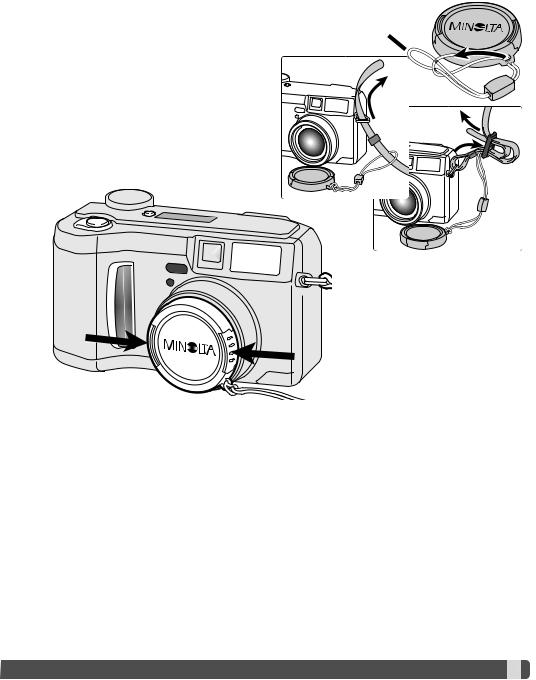
GETTING UP AND RUNNING
ATTACHING THE NECK STRAP AND LENS CAP
Attach the small strap to the lens cap by passing one of the small loops through the eyelet on the cap (1) and then passing the other loop through the first loop (2) and tightening.
Attach the camera strap to the strap eyelets as
shown. Make sure the neck strap passes through the loop of the lens-cap strap. Always keep the
the loop of the lens-cap strap. Always keep the
camera strap around your neck in the event that you drop the camera.
 2
2
 1
1
3 |
4 |
|
Using
pinch the outside tabs of the lens cap to remove or attach. Always replace the lens cap when the camera is not in use.





















































 15
15
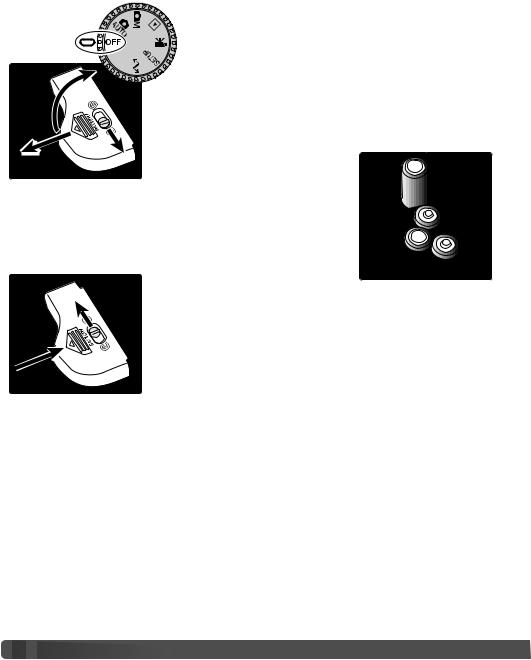
CHANGING BATTERIES
This digital camera uses four AA-size alkaline or Ni-MH batteries. Ni-MH batteries are recommended because of longer life. When using Ni-MH batteries, fully recharge them with a battery charger suitable for complex electronic equipment. Please consult your vendor about an appropriate charger.
When replacing batteries, the mode dial should be in the off position. If the camera is not turned off when replacing exhausted batteries, the low-battery warning may not reset.
3
Open the battery-chamber door by moving the battery-chamber lock (1) 1 to the open position. Slide the door forward (2) to release the safety
catch; the door should spring open (3).
2
Insert the batteries. Make sure the positive and negative battery terminals are oriented as illustrated on the diagram in the battery chamber.
5
Close the battery-chamber door and slide it back toward the body (4) to engage the safety catch. Move the lock lever (5) to the close position.
After installing the batteries, the set-time/date message may appear on the monitor. The clock and calendar are set in the custom 2 section of
the setup menu (p. 20).
4
 16
16 
 GETTING UP AND RUNNING
GETTING UP AND RUNNING 





































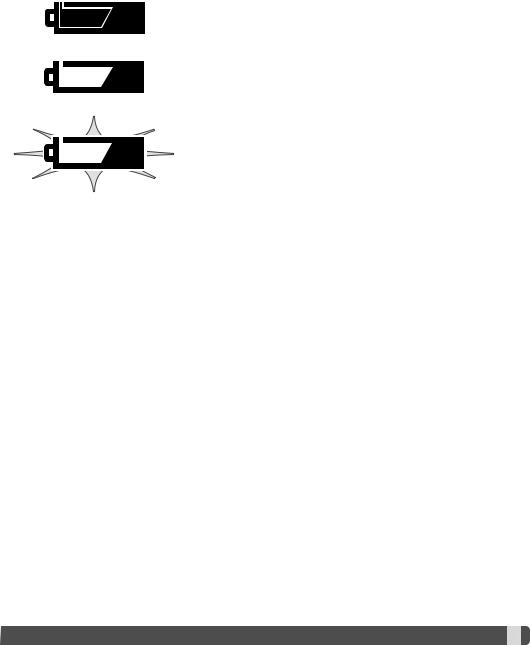
BATTERY CONDITION INDICATOR
This camera is equipped with an automatic battery-condition indicator. When the camera is on, the battery-condition indicator appears on the data panel and monitor. The monitor icon will change from white to red when battery power is low. If the data panel and monitor are blank, the batteries may be dead or installed incorrectly.
Full-battery Icon - the batteries are fully charged. This icon is displayed for five seconds on the monitor when the camera is turned on. The icon remains on the data panel.
Low-battery warning - battery power is very low. The batteries should be replaced as soon as possible. This warning automatically appears and remains on the monitor until the batteries are changed.
Blinking low-battery icon - when displayed on the data panel with no other icons, power is insufficient for camera operation. The shutter will not release. When replacing exhausted batteries, wait thirty seconds between removing the old batteries and inserting the new ones.
When installing batteries, make sure the battery terminals are clean. Residue or dirt on the terminals can sometimes cause a false low-battery warning. Always use a clean, dry cloth to clean batteries.
AUTO POWER SAVE
To conserve battery power, the camera will turn off displays and unnecessary functions if an operation is not made within a certain period. The LCD monitor will turn off after thirty seconds. The data panel turns off after one minute. To restore the displays, press any button or key, or turn the mode dial to another position. The length of the auto-power-save period for the data panel can be changed in the basic section of the setup menu (p. 84).





















































 17
17

EXTERNAL POWER SUPPLIES (SOLD SEPARATELY)
The AC Adapter allows the camera to be powered from an electrical household outlet. The AC Adapter is recommended when the camera is interfaced with a computer or during periods of heavy use. AC Adapter model AC-1L is for use in North America, Japan, and Taiwan; AC-2L is for use in all other areas.
The External High-power Battery Pack Kit EBP-100 is a portable source of power for the camera. The kit contains a high-power lithium-ion battery, holder, and charger. The battery and charger are also available separately. This battery pack will significantly extend the operating time of the camera.
Always turn off the camera before changing between power supplies.
Remove the DC terminal cover from the left. The cover is attached to the body to prevent loss.
Insert the mini plug of the AC adapter or battery pack into the DC terminal. Always remove exhausted batteries before connecting an external power supply. Wait thirty seconds between removing the old batteries and plugging in the external power source.
Insert the AC adapter plug into an electrical outlet.
CHANGING THE COMPACTFLASH CARD
A type I CompactFlash card must be inserted for the camera to operate. If a card has not been inserted, a no-card warning will automatically be displayed on the monitor and three dashes (– – –) will be displayed on the data-panel frame counter. For CompactFlash card care and storage, see page 109.
 18
18 
 GETTING UP AND RUNNING
GETTING UP AND RUNNING 





































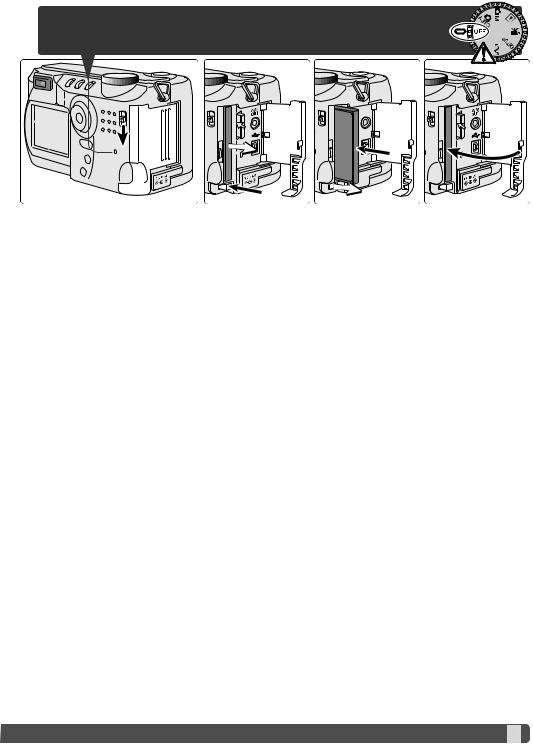
Always turn off the camera and confirm the access lamp is not lit before inserting or removing a CompactFlash card, otherwise the card may be damaged, and data lost.
1 |
2 |
3 |
4 |
Slide the card-slot door release down to open the card-slot door (1).
To eject a CompactFlash card, press the card-eject lever (2). The card can now be pulled out. Take care when removing the card as it becomes hot with use.
Insert the memory card into the card slot until the card-eject lever pops out (3). Insert the card so the face is toward the front of the camera. Always push the card in straight, never at an angle. Never force the card. If the card does not fit, check that it is oriented correctly.
Close the card-slot door (4).
A card used in another camera may have to be formatted before being used. A card is formatted in the basic section of the setup menu (p. 84); this operation permanently erases all data on the card. If the unable-to-use-card message appears, the card is not compatible with the camera and cannot be formatted.





















































 19
19
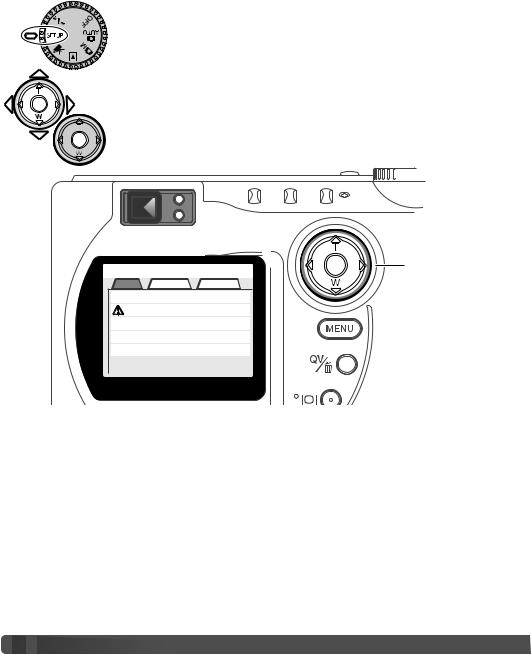
SETTING THE DATE AND TIME
After initially inserting a memory card and batteries, the camera’s clock and calendar must be set. When images are recorded, the image data is saved with the date and time of recording. Depending on the region, the menu language may also have to be set. To change the language, see the camera notes on the following page.
Turn the mode dial on the top of the camera to the setup position. The camera will turn on and the setup menu will be displayed.
Navigating the menu is simple. The up/down and left/right keys of the controller move the cursor and change settings on the menu.
Pressing the center of the controller selects menu options and sets adjustments.
Setup |
|
Controller |
|
|
|
Basic Custom1 |
Custom2 |
|
LCDbrightness |
3 |
|
Format |
– |
|
Power save |
1 min. |
|
Language |
English |
|
Display mode |
– |
|
 20
20 
 GETTING UP AND RUNNING
GETTING UP AND RUNNING 





































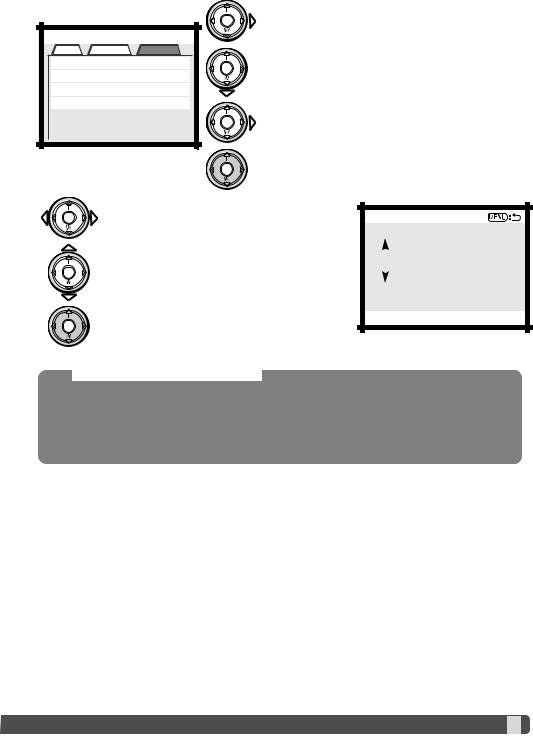
Setup |
|
|
|
Basic |
Custom1 |
Custom2 |
|
Reset default |
– |
|
|
Date/Time set |
– |
|
|
Date format |
MM/DD/YYYY |
||
Video output |
NTSC |
||
Use the right key to highlight the custom 2 tab at the top of the menu.
Use the down key to highlight the date/time-set menu option.
Press the right key. “Enter” will appear on the right side of the menu.
Custom 2 section of the setup menu
Press the center of the controller to display the date/time setting screen.
Use the left and right keys to select the item to be changed.
Use the up and down keys to adjust the item.
Press the center of the controller to set the clock and calendar. The setup menu will be displayed.
Setup Date/Time set
|
. |
20 |
. |
2003 |
|
16 |
: |
33 |
Enter
Date/Time setting screen
Camera notes
For customers in certain areas, the menu language must also be set. Highlight the language option in the basic section of the setup menu. Press the right key to display the language settings. Using the up/down keys, highlight the desired language. Press the center of the controller to set the highlighted language; the setup menu will be displayed in the selected language.





















































 21
21
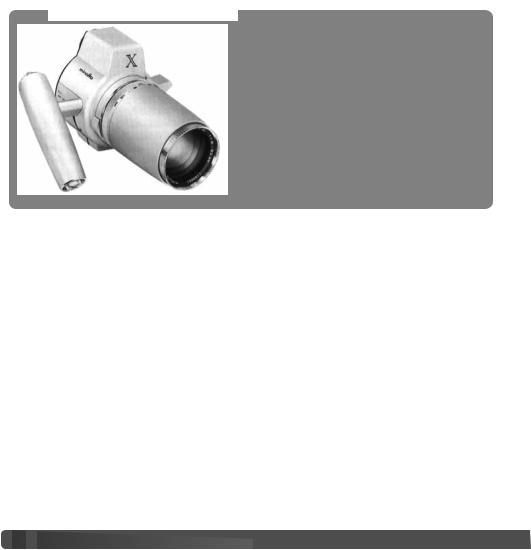
AUTO-RECORDING MODE
BASIC OPERATION
This section covers the basic operation of this camera. Thoroughly familiarize yourself with the operations in this section before moving on to the other sections in the manual.
The sophisticated technology employed in the auto-recording mode frees the photographer from complicated camera settings to be able to simply concentrate on the subject and composition. Although automated, the camera’s operation can be changed to meet various conditions as well as to suit personal shooting preferences.
Minolta History
Innovation and creativity has always been a driving force behind Minolta products. The Electro-zoom X was purely an exercise in camera design. It was unveiled at Photokina in Germany in 1966.
The Electro-zoom X was an electronically controlled aperture-priority mechanical SLR with a built-in 30 - 120mm f/3.5 zoom lens giving twenty 12 X 17mm images on a roll of 16mm film. The shutter-release button and battery chamber are located in the grip. Only a few prototypes were built making it one of Minolta’s rarest cameras.
 22
22 
 AUTO-RECORDING MODE - BASIC OPERATION
AUTO-RECORDING MODE - BASIC OPERATION





























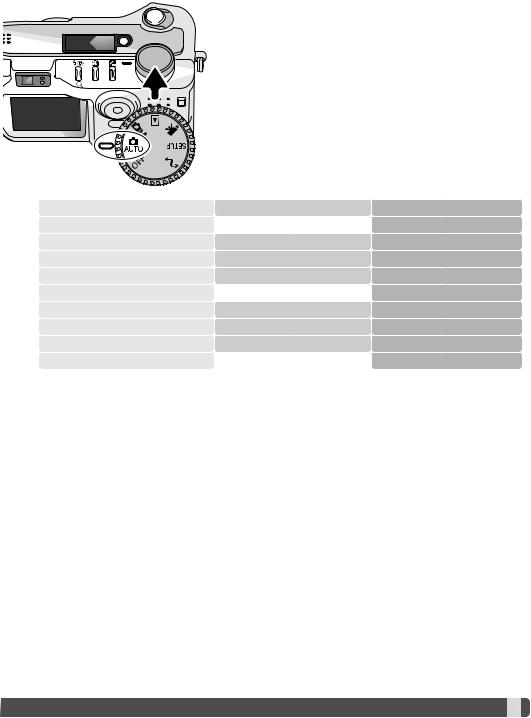
SETTING THE CAMERA TO RECORD IMAGES AUTOMATICALLY
Turn the mode dial to automatic recording (1); all camera operations are now fully automatic. The autofocus, exposure, and imaging systems will work together to bring beautiful results effortlessly.
While many of the camera’s systems in this mode are automatic, the camera’s operation can be optimized to different subjects very simply with the digital subject program button (p. 28). The flash mode (p. 30) and drive mode (p. 32) can also be changed. Image size and quality can be set on the autorecording mode menu (p. 42).
1
Exposure mode |
Program |
Fixed |
Metering mode |
Multi-segment |
Fixed |
Camera sensitivity (ISO) |
Auto |
Fixed |
Flash mode |
Auto flash |
Can be changed* |
Focus area |
Wide focus area |
Fixed |
Focus control |
Autofocus |
Fixed |
Drive mode |
Single-frame advance |
Can be changed* |
Exposure compensation |
0.0 |
Can be adjusted* |
Color mode |
Natural Color |
Fixed |
White balance |
Auto |
Fixed |
*Changes to the flash or drive mode will reset when the mode dial is turned to another position. Adjustments made with exposure compensation will be reset to 0.0 when the camera is turned off or changed to another mode.





















































 23
23
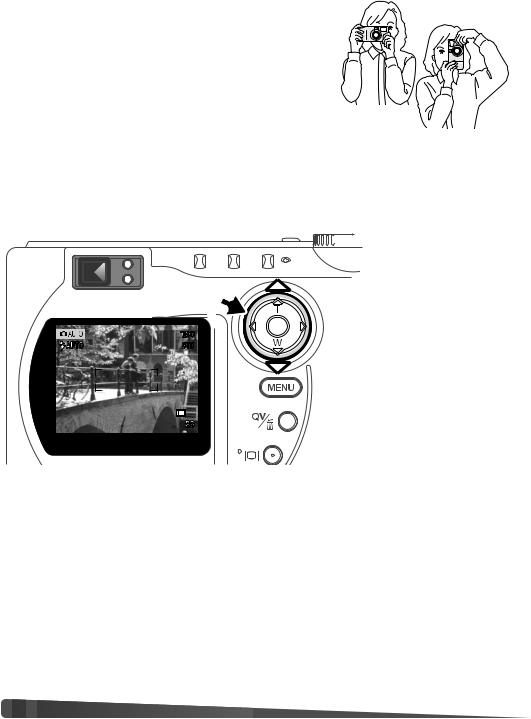
HANDLING THE CAMERA
While using the viewfinder or LCD monitor, grip the camera firmly with your right hand while supporting the body with your left hand. Keep your elbows at your side and your feet shoulder-width apart to hold the camera steadily.
When taking vertical pictures, hold the camera so that the flash is above the lens with the grip to the bottom. Take care not to cover the lens with your fingers or the strap.
USING THE ZOOM LENS
This camera is equipped with a 7.15 to 28.6mm optical zoom. This is equivalent to a 35 - 140mm zoom lens on a 35mm camera. In 35mm photography, focal lengths below 50mm are referred to as wide-angle; the angle of view is larger than that of the human eye. Above 50mm is referred to as telephoto and makes distant objects appear closer. The effect of the optical zoom is visible in both the viewfinder and LCD monitor.
Controller |
The zoom lens is operated by |
|
the controller. Pressing the up |
||
|
||
|
key (T) will zoom in to the |
|
|
telephoto position of the lens. |
|
|
Pressing the down key (W) will |
|
|
zoom out to the wide-angle |
|
|
position. |
 24
24 
 AUTO-RECORDING MODE - BASIC OPERATION
AUTO-RECORDING MODE - BASIC OPERATION





























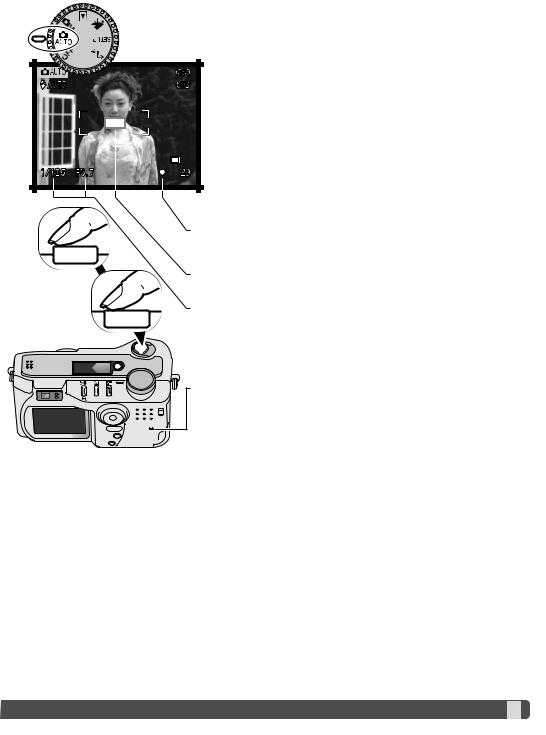
BASIC RECORDING OPERATION
With the mode dial set to auto recording, the camera will be on and the LCD monitor will activate.
Place the subject within the focus frame.
•The focus-lock function (p. 26) can be used with off-center subjects.
•The subject must be within the focus range of the lens: 0.5m - ∞
(wide-angle position), 0.9m - ∞ (telephoto position). For subjects closer than 0.6m, use the macro function (p. 28).
•If the subject is closer than 1m at the wide-angle lens position or 3m at the telephoto lens position, use the LCD monitor to frame the
|
|
|
subject. |
|
|
Press the shutter-release button partway down (1) to lock the focus |
|
1 |
|
and exposure. |
|
|
• |
The focus signals (p. 27) on the monitor will confirm the focus. If the |
|
|
|
||
|
|
|
focus signal is red, the camera was unable to focus on the subject. |
|
|
|
Repeat the previous steps until the signal is white. |
|
2 |
• |
When the focus is set, an AF sensor will briefly appear on the live |
|
|
image to indicate the point of focus. |
|
•The shutter speed and aperture value will change from white to black indicating the exposure is locked.
Press the shutter-release button all the way down (2) to take the picture.
• The access lamp will glow indicating image data is being written to the CompactFlash card. Never remove a memory card while data is being transferred.





















































 25
25
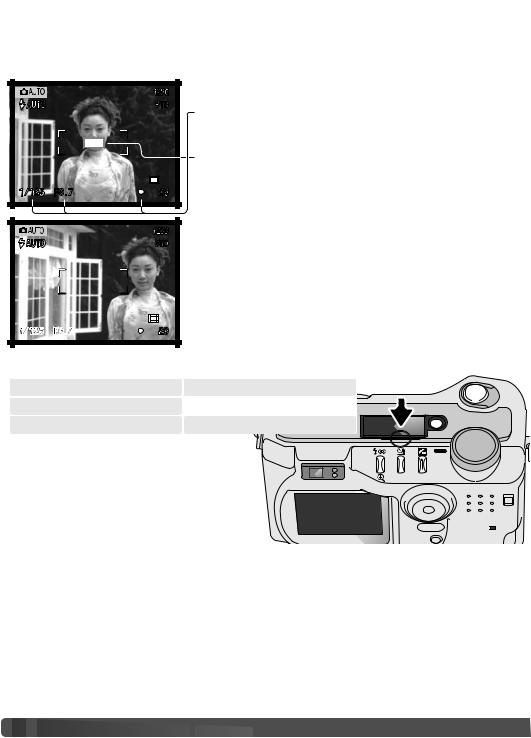
FOCUS LOCK
The focus-lock function is used when the subject is off-center and outside the focus frame. Focus lock may also be used when a special focusing situation prevents the camera from focusing on the subject. This function is controlled with the shutter-release button.
Place the subject within the focus frame. Press and hold the shutter-release button partway down.
• The focus signals will indicate that the focus is locked. The shutter speed and aperture value will change from white to black indicating the exposure is locked.
• When the focus is set, an AF sensor will briefly appear on the live image to indicate the point of focus.
Without lifting your finger from the shutter-release button, recompose the subject within the image area. Press the shutter-release button all the way down to take the picture.
FOCUS RANGE
Wide-angle lens position |
0.5m |
- ∞ (1.6ft - ∞) |
CCD plane |
|
|||
Telephoto lens position |
0.9m |
- ∞ (3ft - ∞) |
|
Macro mode (p. 28) |
0.16m - 0.6m (0.5ft - 2ft) |
|
|
All distances are measured from the CCD.
 26
26 
 AUTO-RECORDING MODE -
AUTO-RECORDING MODE - BASIC
BASIC OPERATION
OPERATION 





























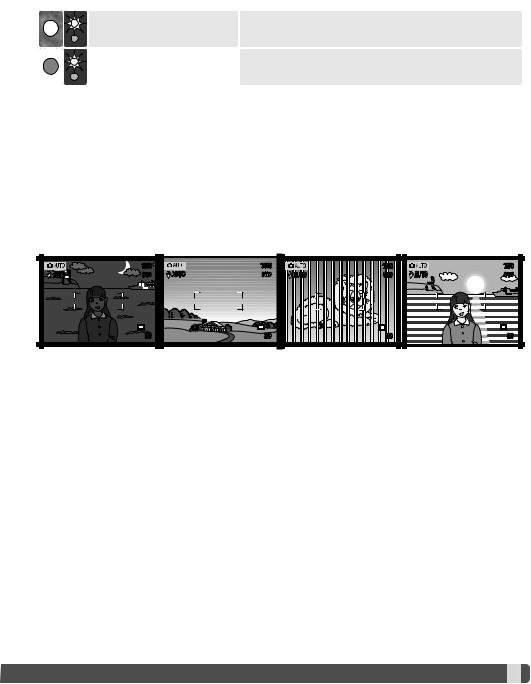
FOCUS SIGNALS
This digital camera has a quick, accurate autofocusing system. The focus icon in the lower right corner of the LCD monitor and the green focus lamp next to the viewfinder indicate the focus status.
Focus icon: white Focus lamp: steady
Focus icon: red Focus lamp: blinking
Focus locked.
Cannot focus. The subject is too close or a special situation is preventing the AF system from focusing.
•The shutter can be released even if the camera cannot focus on the subject.
•When the AF system cannot focus, the focus is set to infinity. When the flash is in use, the focus is set between 3.0 and 3.8m. In this case, focus lock can be used with an object at the same distance as the main subject or the camera can be focused manually in the multi-function recording mode (p. 59).
SPECIAL FOCUSING SITUATIONS
The camera may not be able to focus in certain situations. If the autofocus system cannot focus on a subject, the focus icon will turn red. In this situation the focus-lock function can be used to focus on another object at the same distance as your main subject, and then the image can be recomposed to take the picture.
The subject is too dark. The subject in the |
Two subjects at |
The subject is near a |
focus frame is low in |
different distances |
very bright object or |
contrast. |
overlap in the focus |
area. |
|
frame. |
|





















































 27
27
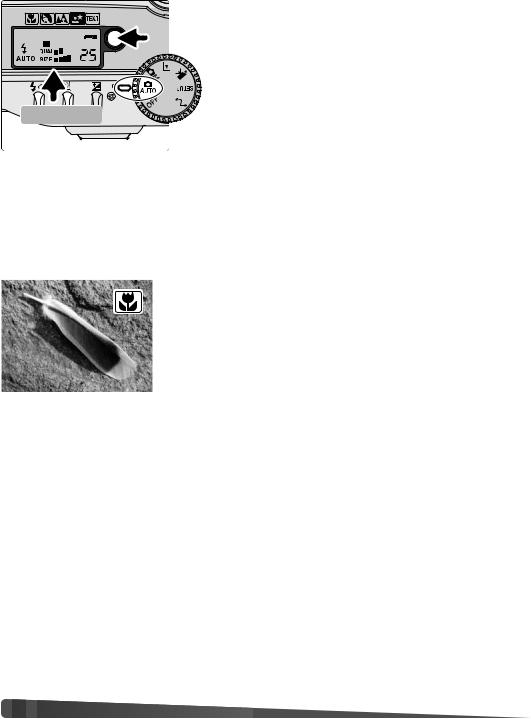
DIGITAL-SUBJECT-PROGRAM BUTTON
1 |
CCD plane
The digital-subject-program button (1) optimizes the camera’s exposure, white-balance, and image-processing systems for various conditions and subjects. Pressing the subject-program button cycles through the modes: macro, portrait, landscape, night portrait, text, macro & text, and the original exposure mode. A pointer will indicate the active subject program. The subject program will remain in effect until it is changed or the mode dial is turned to another position. Except for macro, digital subject programs cannot be used in the multi-function recording mode.
While subject programs optimize camera performance for each shooting condition, some changes can be made to
camera settings. The flash mode (p. 30) can be changed and the exposure can be altered using the exposure-compensation function (p. 50). In extreme lighting conditions, changes in exposure compensation may not produce the intended results in the portrait, night portrait, or text modes. The camera-shake warning (p. 31) may appear in macro, landscape, night portrait, or text modes.
MACRO - used for close-up photography between 16 and 60 cm (6 ~ 24in.) from the CCD. When the macro mode is selected, the lens will automatically zoom to the correct position. The zoom position cannot be changed. The LCD monitor should be used to compose the picture and will automatically activate if off. The viewfinder cannot be used because of parallax. The flash is set to flash cancel (p. 30). Fillflash can be used, but can cause extreme overexposure and uneven illumination.
This subject program can be used in the multi-function recording mode. It will not reset if the position of the mode dial is changed.
 28
28 
 AUTO-RECORDING MODE - BASIC OPERATION
AUTO-RECORDING MODE - BASIC OPERATION





























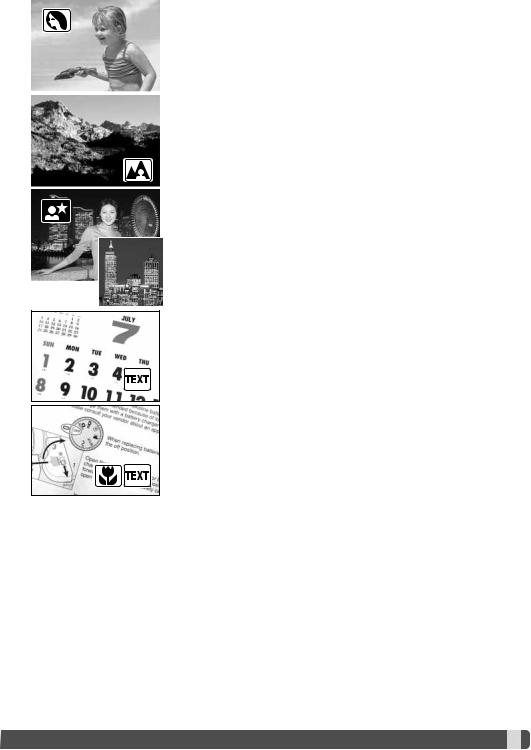
PORTRAIT - optimized to reproduce soft skin tones and a slight defocusing of the background. The flash mode can be changed (p. 30). Most portraits look best at a telephoto setting; longer focal lengths do not exaggerate facial features and the shallower depth of field softens the background.
LANDSCAPE - optimized to produce sharp, colorful landscapes. The flash mode is set to flash cancel. Fill-flash can be used (p. 30).
NIGHT PORTRAIT - for deep, subtle night scenes. When used with fillflash, the subject and background exposures are balanced. When taking pictures of a landscape at night, use a tripod to eliminate blurring from camera shake. To take portraits with night scenes, set the flash mode to fill-flash (p. 30). Ask your subject not to move after the flash burst; the shutter will still be open for the background exposure.
TEXT - for the crisp reproduction of black text or line art on white backgrounds. The flash mode is set to flash cancel (p. 30). Fill-flash can be used. Use a tripod to eliminate camera shake and ensure the sharpest images.
MACRO & TEXT - for close-up images of text or line art between 16 -
60cm (6 ~ 24in.) from the CCD. Two pointers will indicate the combined modes on the data panel and the macro and text indicators will be displayed on the monitor. The use of a tripod is recommended. The flash is set to flash cancel. Fill-flash can cause extreme overexposure and uneven illumination.





















































 29
29

FLASH MODES
To set the flash mode, simply press the flash mode button (1) on the back of the camera until the desired mode is displayed.
Autoflash - the flash fires automatically in low-light and backlit conditions.
Fill-flash - the flash fires with each exposure regardless of the amount of ambient light. Fill-flash can be used to reduce harsh shadows caused by strong direct light or sunshine.
1 |
Flash cancel - the flash will not fire. Use flash cancel when flash photography is prohibited, natural light is desired to illuminate the subject, or the subject is beyond the flash range. The camerashake warning may appear when flash cancel is selected (p. 31).
Red-eye reduction - the flash fires twice before the main flash burst to reduce red-eye; an effect caused by light reflected from the retina. Use in low-light conditions when taking photographs of people or animals. The pre-flashes contract the pupils of the subject’s eyes.
Autoflash
Fill-flash
Flash cancel
Autoflash with red-eye reduction
Fill-flash with red-eye reduction
 30
30 
 AUTO-RECORDING MODE - BASIC OPERATION
AUTO-RECORDING MODE - BASIC OPERATION





























